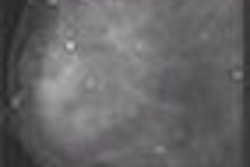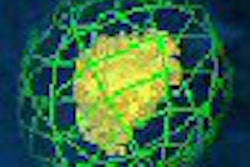
Since 1998 more than 2,100 mammography computer-aided detection (CAD) systems have been sold, and presumably these systems are regularly being used by hospital radiology departments and imaging centers in the U.S. The U.K. is another story, however. Mammography CAD technology has not yet been deployed at the 97 breast screening units of the National Health Service (NHS).
In addition to the goal of reducing the number of overlooked or difficult-to-detect cancers, motivation in the U.S. to utilize mammography CAD systems is also influenced by two important underlying factors: the potential to reduce malpractice lawsuits and to accrue Medicare and Medicaid reimbursement revenue.
The leading cause of radiology malpractice lawsuits in the U.S. is failure to detect breast cancer, while Medicare reimbursement for CAD is $19. With the low reimbursement rates for both screening and diagnostic exams in the U.S. by federal agencies and private insurance companies, CAD reimbursement represents a "cash cow" of sorts for radiology practices and diagnostic imaging departments.
In contrast, the number of malpractice lawsuits in the U.K., while increasing, has not begun to reach the level it has in the U.S. In a country practicing socialized medicine, reimbursement is not an issue. The question asked about CAD technology is whether it can improve upon or replace existing protocols used to detect breast cancer.
Can CAD make a difference?
NHS, which oversees one of the best and most comprehensive breast cancer screening programs of any nation in the world, is unconvinced. Clinical evaluations conducted over the past five years have not made a persuasive case for its implementation.
However, professor Fiona J. Gilbert, head of radiology at the University of Aberdeen in Scotland, and Dr. Susan M. Astley, senior lecturer at the University of Manchester in England, the principal investigators of the recently concluded Computer Aided Detection Evaluation Trial (CADET), believe that their findings merit further immediate evaluation of CAD technology.
"A new prospective clinical trial, conducted at a large number of breast screening centers by a large number of mammography readers, may yield significant results to make the case for immediately utilizing mammography CAD in the United Kingdom," Gilbert said in a presentation at the 2005 Computer Assisted Radiology and Surgery (CARS) conference held in Berlin in June.
She felt that this technology could be extremely useful in breast screening centers that were experiencing acute shortages of qualified mammography readers.
The NHS Breast Screening Programme was initiated in 1988 with the objective of saving lives through the early detection of breast cancer. This national health initiative undoubtedly has contributed to the drop in breast cancer mortality in England, from 78 for every 100,000 women ages 50-64 in 1994 to 58 per 100,000 women in 2003.
Women between the ages of 50-70 are invited to have a mammogram in three-year intervals, and women over 70 can self-refer. Of the eligible population, 75% participates. In 2002/2003, 1.35 million screening mammograms were performed in England. The more than 80,000 additional exams were an increase of 6.3% over 2001/2002, representative of an increasingly larger eligible aging population.
There is also a serious national shortage of mammography readers, even though in the U.K., mammograms are read by radiographers (radiologic technologists) and breast clinicians, as well as radiologists. All are required to meet qualifications significantly more rigorous than those set in the U.S. Minimum reading requirements, for example, are 5,000 exams, as compared to 450 in the U.S.
Even with this larger potential professional workforce, there is a serious manpower shortage. The already heavy workload has been exacerbated by the expansion of the Breast Screening Programme in 2004 from just targeting women ages 50-64, to actively including women ages 65-70.
In 1998/1999, women 65-70 years of age represented approximately 103,450 exams that were performed through self- or physician-referral. In 2003/2004, the year before "age expansion" was fully implemented in the NHS Breast Screening Programme, this number was approximately 180,000, an increase of approximately 73.4%. Significant increases for this age group are expected to continue through the decade.
A similar growth trend is not expected for qualified mammography readers. Because the NHS Breast Screening Programme's established protocol is that all mammograms should be double read, the shortage is even more acute.
NHS CAD studies
"When (CAD) was commercially introduced, the hope for mammography CAD technology was that a single reader using mammography-CAD prompts could alleviate the need for a second reader," said Julietta Patnick, director of the NHS cancer screening programs. "The other hope was that CAD technology would increase the percentage of identified cancers."
When mammograms are double read, cancer detection rates have been documented to increase by 7% to 10%, with as much as a 24% increase for small cancers. Despite these statistics, Gilbert said that "as many as 25% of interval cancers and 19% of incident round cancers are found to have a detectable lesion on the prior screening mammogram that have been overlooked by both readers."
In 2000, the Centre for Health Informatics and Multiprofessional Education at University College London was commissioned by the NHS Health Technology Assessment Board to assess the performance capabilities and potential cost-effectiveness of mammography CAD using ImageChecker (R2 Technology, Sunnyvale, CA).
In the first study, 50 experienced film readers evaluated a test set of 180 cases with and without the use of CAD. The test set included 60 confirmed cancers, which represented an unrealistic ratio of 33%, skewing the results.
A second study was initiated using a test set of 44 cancer cases selected specifically to measure the impact of CAD. These focused on the cases that had been previously missed by the radiologists. Once again, CAD had no impact.
"The studies were specifically designed to be brief in duration and economic to conduct," said studies director Paul Taylor, Ph.D., a senior lecturer in health informatics. "After the results of these studies were published, they were criticized for failing to replicate realistic conditions for the readers. And they did not. Only 1% of screening mammograms in this country are abnormal. From these two trials, we have learned that the cancer ratio can, among many other factors, inappropriately influence this type of study."
A third study was undertaken under Taylor's direction. From March 2003 to January 2004, 6,111 out of 19,502 screening mammograms were processed with CAD at St. George's Hospital in London. Allocation for CAD processing was based on availability of roller viewers that were equipped with screens to display CAD prompts.
After film readers recorded their findings, they then reviewed the films with CAD, noting their findings again. All exams were read by a second reader. A total of 62 cancers were detected, with 1.7% attributed to detection by CAD prompts. (A detailed analysis of each study has been published in the British Journal of Radiology, Clinical Radiology, and the Proceedings of the Seventh International Workshop on Digital Mammography: 2004.)
CADET
The Computer Aided Detection Evaluation Trial (CADET) was designed as a retrospective study in 2003 by the University of Aberdeen and the University of Manchester to determine if single reading with CAD was equivalent to double reading.
The study randomly selected 15,000 women who had screening mammograms taken and double read in 1996 at either the Aberdeen or Manchester breast screening facilities. The test mix included all cases in which cancers were detected in this group, either with the 1996 examination or in subsequent examinations up through the 1999 mammogram.
The researchers selected 10,000 normal cases from the group, as well as a small number of additional cancer cases specifically selected to diversify and enrich the cancer mix.
Twelve readers (eight radiologists, three radiographers, and one breast physician) representing the range of experience of the clinical staff at each facility in 1996 were trained to use and become proficient with CAD over a seven-week period prior to the start of the trial. Each of the mammograms was read by a single reader using CAD, and the results were compared with the double-read interpretation made in 1996.
Preliminary results were presented in 2004 at the Seventh International Workshop on Digital Mammography, at which time CADET was 75% complete. Both preliminary and final results produced similar statistics.
Astley and Gilbert said that the CADET study not only showed that single reading with CAD detected significantly more cancers than the 1996 double reading, but also produced a higher recall rate. (Detailed results of the CADET study have been submitted as a prospective article to Radiology, and are currently in review.)
"From an economic standpoint, the cost of cancer treatment at its earliest identifiable stages is significantly less than when the disease is more advanced," Astley said. Because of its complexity, no evaluation has been made comparing the actual cost (adjusted to 2004 currency equivalency) for the treatment of patients with undetected cancers with the estimated cost of treatment had the cancers been detected at the time the mammograms were performed. The CADET researchers therefore do not know how the cost of treatment would have compared to the cost of purchasing CAD equipment.
In an interview with AuntMinnie.com, Patnick said that "costs associated with CAD implementation today that would also need to be factored include the opportunity cost of a potential reading slowdown that use of CAD may cause, as well as the cost of an increase in recalls."
She referenced a recent evaluation (Rebecca Smith-Bindman et al, "Comparison of Screening Mammography in the United States and the United Kingdom," Journal of the American Medical Association, October 22, 2003, Vol. 290:16, pp. 2129-2137) that compared the performance of screening mammography in the U.K. and the U.S. in a sample of women over age 50 who participated in the NHS Breast Cancer Screening Programme (U.K.) and the Breast Cancer Surveillance Consortium (U.S.) between 1996 and 1999.
The recall rate after an initial screening mammogram was 7.2% in the U.K. and 13.3% in the U.S.
"Based on the results of several published studies, if CAD had been used extensively in the United States at the time, the percentage of initial recalls may have even been higher," Patnick said.
Astley and Gilbert believe that the throughput performance of U.K. readers, like U.S. readers, would return to "normal" levels with regular use of CAD. They also think it is likely for recall rates to fall to "normal" levels as well. If the cost of an additional percentage of recalls over the norm increased the percentage of small invasive and in situ cancers discovered, it might be negated by reduced treatment costs.
Based on the CADET results, Astley and Gilbert are recommending that a large-scale progressive study of short duration, with participation by a large representative mix of the 97 national screening centers, be initiated to determine that single reading with CAD (and arbitration) will be equivalent to double reading (and arbitration).
Such a large study is expensive to conduct, however. The cost to obtaining patient consent of 54,000 women alone is estimated at 200,000 pounds (equivalent to $380,000).
At what point should testing to validate the adoption of and investment in a rapidly evolving technology stop? How long should the NHS wait for mammography CAD technology to attain the levels of sensitivity and specificity deemed appropriate for national implementation? In the U.K., these questions remain unanswered.
By Cynthia Keen
AuntMinnie.com contributing writer
October 4, 2005
Related Reading
Computer-aided detection system helps diagnose breast cancer, September 6, 2005
Despite flaws, lung CAD earns second-reader role, September 5, 2005
CAD marks: To save or not to save? September 1, 2005
Management strategies evolve as CT finds more lung nodules, August 19, 2005
Part II: Computer-aided detection identifying new targets, July 15, 2005
Copyright © 2005 AuntMinnie.com



















